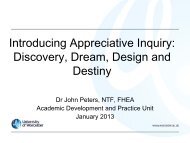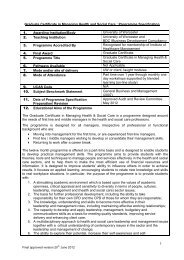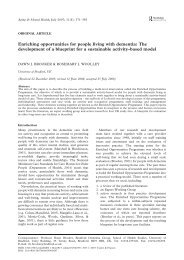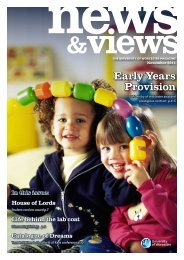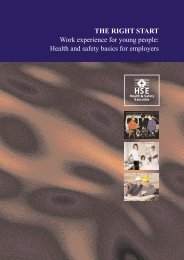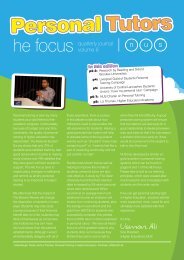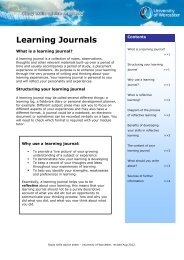Including children with cerebral palsy in mainstream physical
Including children with cerebral palsy in mainstream physical
Including children with cerebral palsy in mainstream physical
Create successful ePaper yourself
Turn your PDF publications into a flip-book with our unique Google optimized e-Paper software.
Hilderley & Rh<strong>in</strong>d<br />
<strong>Includ<strong>in</strong>g</strong> <strong>children</strong> <strong>with</strong> cp <strong>in</strong> <strong>physical</strong> education<br />
The support workers thought be<strong>in</strong>g <strong>in</strong> a wheelchair was a barrier. One support<br />
worker drew attention to temperature control for a wheelchair user. She said, “When<br />
it’s cold or ra<strong>in</strong><strong>in</strong>g most students just go out and play sport, the weather doesn’t<br />
matter. When you’re <strong>in</strong> a wheelchair you can’t just warm yourself up though.” On the<br />
topic of ra<strong>in</strong> several members of staff <strong>in</strong>dicated mud on the field was a barrier for<br />
wheelchair users. The second assistant was concerned over the health and safety of<br />
other students. The wheelchair user has to be aware of other students and she felt<br />
they were excluded from certa<strong>in</strong> th<strong>in</strong>gs us<strong>in</strong>g the example of a rugby tackle. Whilst<br />
ramm<strong>in</strong>g <strong>in</strong>to someone <strong>with</strong> a wheelchair would be an effective way of tackl<strong>in</strong>g them<br />
it’s clearly not safe.<br />
Attitudes<br />
Further potential barriers concerned the attitudes of peers, staff, and the child.<br />
Firstly, a barrier could be the attitude of the able-bodied peers. Jo found some<br />
students were not sure how to react around her, she said some peers “weren’t so<br />
keen <strong>in</strong> gett<strong>in</strong>g me <strong>in</strong>volved, but the ones who knew me were OK <strong>with</strong> me be<strong>in</strong>g<br />
<strong>in</strong>volved because they understood my limits”. Jo also said she preferred to do her<br />
physiotherapy exercises alone so she didn’t feel like she was be<strong>in</strong>g watched and<br />
judged. One teach<strong>in</strong>g assistant acknowledged the attitude of peers as a potential<br />
barrier, but didn’t th<strong>in</strong>k it had been an issue at this school.<br />
The attitudes of the staff were also highlighted as play<strong>in</strong>g an important role. The<br />
teachers and support workers all believed they had made an effort to encourage<br />
students <strong>with</strong> disabilities and create an <strong>in</strong>clusive teach<strong>in</strong>g environment. Both Jo and<br />
Sam supported this view. However, Ali said he felt “patronized by some PE staff<br />
regularly”. He gave the example of them ask<strong>in</strong>g his carer if he was capable of do<strong>in</strong>g<br />
someth<strong>in</strong>g.<br />
The attitude of the child also had the potential to represent a barrier, or a means by<br />
which barriers can be overcome. On the one hand, the staff members described how<br />
it could be difficult to work <strong>with</strong> <strong>children</strong> <strong>with</strong> CP if they did not wish to participate.<br />
One teacher recalled aid<strong>in</strong>g a girl <strong>with</strong> severe CP to hold a tennis racket and to hit a<br />
ball. Whilst the girl could not have participated <strong>with</strong>out this help she was reluctant to<br />
it and “reluctant to try”. On the other hand, the students <strong>with</strong><strong>in</strong> this sample all<br />
appeared to have a positive attitude and to be motivated to work towards<br />
overcom<strong>in</strong>g any barriers. This is supported by the fact that they have gone on to be<br />
<strong>physical</strong>ly active after leav<strong>in</strong>g school and, <strong>in</strong> one case, to participate at the<br />
<strong>in</strong>ternational level.<br />
Suggested Improvements<br />
The participants were also <strong>in</strong>vited to highlight ways <strong>in</strong> which <strong>children</strong> <strong>with</strong> CP could<br />
be more effectively <strong>in</strong>cluded <strong>in</strong> PE classes <strong>in</strong> the future. The most common area of<br />
improvement participants suggested was teacher tra<strong>in</strong><strong>in</strong>g. One support worker<br />
stated, “A lot of PE teachers don’t have a true <strong>in</strong>sight <strong>in</strong>to the needs of students <strong>with</strong><br />
a disability.” This view was supported by Ali, who felt some staff patronized him<br />
because they didn’t understand what his condition was. A second support worker<br />
agreed more tra<strong>in</strong><strong>in</strong>g was needed, for PE teachers, <strong>in</strong> this area. She knew a newly<br />
qualified teacher who had no experience at all <strong>with</strong> <strong>children</strong> who have a disability.<br />
The SEN staff agreed a module on disability should be <strong>in</strong>cluded <strong>in</strong> teacher tra<strong>in</strong><strong>in</strong>g or<br />
<strong>in</strong> on-go<strong>in</strong>g professional development courses. The PE teachers agreed <strong>with</strong> these<br />
© 2012 GJSEPER 10



